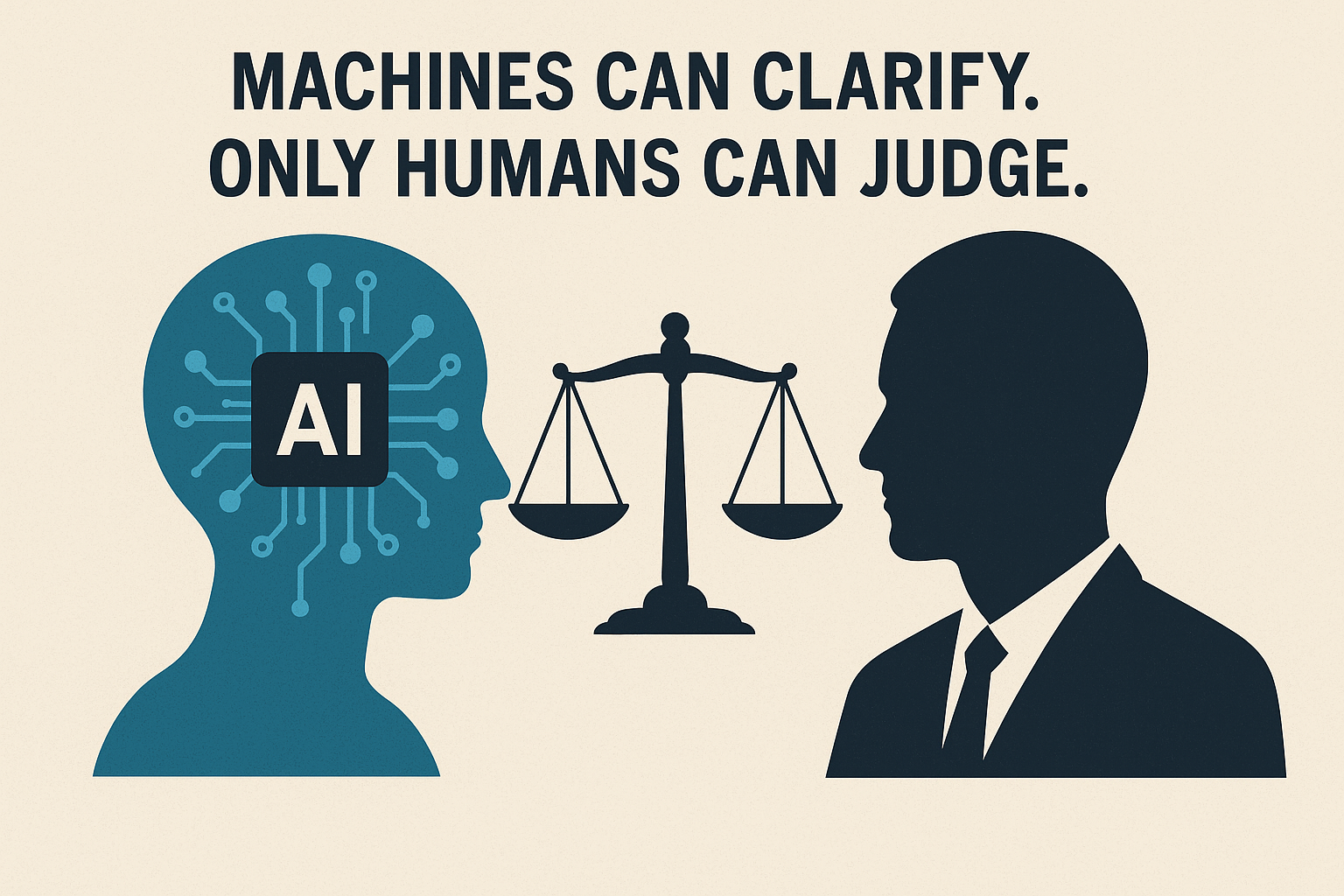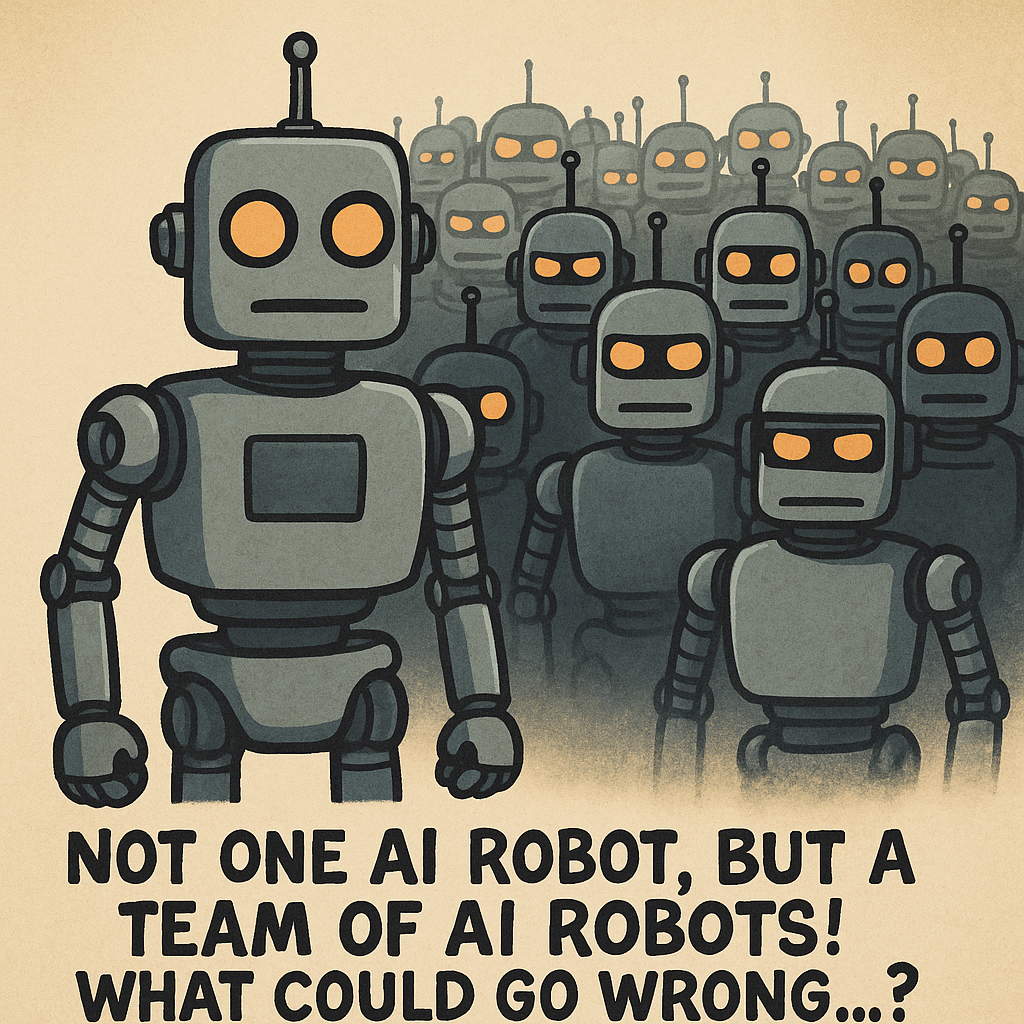Machines Can Clarify. Only Humans Can Judge.
In this article series, we have seen how human decision-makers are vulnerable to bias, fear, and institutional pressure—and how machine outputs, far from solving these problems, often amplify them.
In Part 1, my abrupt firing as a school tennis coach—without warning, without any discussion let alone a hearing—demonstrated how broken incentives and lack of due process can destroy careers with no accountability.
In Part 2, we saw how deploying artificial intelligence as a decision-maker risks entrenching these injustices behind a veneer of objectivity, making them even harder to detect or challenge.
But the optimal—and perhaps only—application for AI in our adjudicative processes is not its ability to pass judgment. It is in organizing complexity to improve human decision-making.
Machines can surface facts and structure arguments. But they cannot weigh fairness, assess credibility, or understand dignity.
If we respect those limits, AI can strengthen due process—not erode it.
…
VIII. AI is the Ultimate Junior Associate or Paralegal
Artificial intelligence should not replace human judgment in adjudication. But properly structured AI agents—each with a distinct, limited role—can organize complexity, surface key disputes, and dramatically lower the cost of fairness.
The real superpower of AI is not its analytical brilliance, but its ability to ingest, summarize, and identify key points from massive volumes of information almost instantaneously. What would otherwise require hundreds of junior associate or paralegal hours—at hundreds of dollars per hour—can now be accomplished in seconds and at almost no cost. Used properly, AI can strip away the noise, surface what matters, and focus human judgment where it belongs: on weighing evidence, credibility, and fairness.
Here’s how we can build a system that leverages AI’s unprecedented capabilities to strengthen due process, not undermine it.
IX. A Better Model: Role-Segregated AI Agents and Human Judgment
When we imagine AI assisting in adjudication, we must resist the tendency to treat “AI” as a single, monolithic actor.
Just as human adjudication divides roles between judges, juries, and advocates—each with distinct responsibilities and limits—AI assistance could be similarly structured.
Different AI agents could be trained and deployed for different tasks:
- One to neutrally organize the factual and legal landscape.
- Others to advocate for each party’s strongest positions.
Segregating these roles helps prevent automation bias, preserves procedural fairness, and ensures that ultimate moral judgment remains firmly in human hands.
Properly designed, an AI-assisted system doesn’t replace human processes—it clarifies and strengthens them.
A. AI Agent No. 1: Framing the dispute
When I was relieved of my tennis coaching duties, there was no organized record—just a written complaint and a risk-management-driven decision.
No structured review. No opportunity to contest the allegations.
An AI agent trained only to organize the factual landscape could have made a critical difference:
- Summarizing and framing the issues,
- Separating uncontested facts from disputed ones,
- Flagging credibility questions for human evaluation,
- Highlighting procedural gaps, such as lack of notice and hearing.
A properly implemented AI Agent No. 1 could offer the best of both worlds: the efficiency of neutral framing without sacrificing the adversarial right to challenge and supplement the record.1
Framing factual and legal disputes upfront—without resolving them—would replicate the best aspects of systems where appointed neutrals structure proceedings early.2
Done right, this could lead to faster, fairer, and far more cost-effective adjudications.
B. Agent Nos. 2 and 3: Framing the best arguments for each side
Once the record is neutrally framed, AI Agent Nos. 2 and 3 could separately generate preliminary arguments:
- One for the plaintiff,
- One for the defendant.
Each AI agent would outline the strongest legal claims and defenses, citing evidence surfaced in the framed record.
But machines would not argue the case.
Human attorneys would supplement, refine, humanize, and advocate the positions—especially where disputed facts and credibility judgments matter most.
Machines organize. Humans advocate and persuade.
C. The human judge: Referee and final decider
Ultimately, a human decision-maker must hear live testimony, assess credibility, and render judgment.
No machine can decide whether a tone was threatening or a complaint was retaliatory. No algorithm can assess the emotional impact or good faith behind human actions.
Machines help us hear the record more clearly. But only humans can choose to listen fairly—and decide justly.
D. Practicality and Path Forward
In theory, this is how all attorneys should already be integrating AI into their litigation practices: streamlining organization, clarifying disputes, and leaving human judgment where it belongs.
But the reality is that the billable hour still incentivizes inefficiency in many legal settings.
The real innovation with respect to utilizing AI will likely come first in private mediation and alternative dispute resolution, where parties have more flexibility and stronger incentives to resolve disputes efficiently.
It is not a matter of if courts and adjudicative systems (formal and informal) will adopt these models. It is only a matter of when.
Because “justice delayed is justice denied.” AI, properly implemented, finally offers a cure that meaningfully addresses this practical reality, in a faster, fairer, and more accessible manner than anything the traditional system has yet delivered.
[cont’d ↗]
X. Access to Justice Benefits
“The question is not whether AI will reshape adjudication. It is whether we will use it to strengthen human judgment—or surrender it.”
A. No due process rights for private employees …
As noted in Part 1, due process is a constitutional promise that the government can’t take away your life, liberty, or property without following fair procedures.
But in American employment law, due process is the exception, not the rule. Across all fifty states, the default standard in the private sector is at-will employment: employers can fire workers for any reason, a bad reason, or no reason at all—without giving notice, an explanation, or a chance to respond. Unless protected by a specific contract, union agreement, or limited anti-discrimination statutes, most employees have no legal right to a hearing or even a conversation before being terminated. Fairness is optional, not mandatory.
The primary justifications for withholding due process protections from private-sector employees have historically been freedom of contract and managerial discretion—the idea that employers need broad authority to manage operations efficiently, and that employees voluntarily accept the risks of at-will termination. Another practical justification is the desire to minimize frivolous litigation: without at-will employment, virtually every termination could trigger a wrongful discharge lawsuit, burdening employers with costly, time-consuming defenses even against meritless claims.3
Maintaining a no-cause termination rule is seen as a necessary safeguard against paralyzing the workforce management process through constant legal second-guessing.
B. … but with the efficiencies made possible by AI-assisted adjudication, should there be in some cases?
But in an era where increasingly complex, opaque systems like AI influence employment decisions, the traditional assumptions of equal bargaining power and transparent management practices grow even harder to defend.4
AI, however, giveths here as well. By rethinking the litigation process—using AI to organize disputes efficiently, as discussed above—we could drive down the cost of litigation exponentially, while increasing transparency and preserving fairness.
This shift would not necessarily justify broader due process protections for all private-sector employees. Different circumstances may call for different levels of procedural protection, depending on the nature of the job, the stakes involved, and the broader public interest. What matters is that AI-assisted efficiencies give us the flexibility to calibrate due process appropriately—without having to deny it entirely on grounds of cost.
Small business owners, for instance, should have the general right to retain flexibility to manage operations efficiently. Or not. It’s their business, so long as they are not violating prospective or current employees’ civil rights.
But when it comes to teachers, coaches, and other educators entrusted with our students’ welfare, the justification for denying basic due process principles evaporates. Education is a public good. It’s not just the administrators’ or the schools’ business. Students and parents have an important stake as well. Once the excuse of prohibitively expensive litigation falls away, what remains is only a question of will—and of recognizing the humanity of those who serve. And the rights of those they serve—the students (not the administrators…).
XI. Guardrails Needed
Any AI-assisted adjudicative system requires critical safeguards:
A. Discovery integrity
AI can only work with what it is given. Withholding key evidence corrupts not just the opposing party’s case, but the integrity of the entire AI framing process.
Strong, enforceable discovery rules would be even more essential than ever. Without complete and truthful inputs, even the most sophisticated AI can only produce distorted outputs—undermining the adversarial process at its foundation.
B. Transparency and reviewability
Secret AI processes would turn adjudication into a black box. Fairness demands that every AI step be open to scrutiny, challenge, and correction.
All AI outputs must be logged, disclosed, and available for challenge, namely in the courts. There can be no hidden algorithms where rights, careers, and reputations are at stake.

XII. Conclusion: Justice Must Remain Human
When I was abruptly dismissed from coaching our school’s tennis teams—with no warning, no discussion, and no meaningful opportunity to explain—the experience was painful. But it was also eye-opening. It exposed how, even assuming good intentions, institutional pressures can distort fairness and how easily human dignity can be sidelined when there are no structural safeguards to promote accountability, fairness, and decision-making grounded in truth.
That said, it would be unrealistic to suggest that every coaching dispute—or every employment decision—demands a full independent hearing. Schools, like many institutions, operate under immense pressures: tight budgets, legal risks, reputational sensitivities, and the need to maintain an orderly environment for students and staff alike. Administrators must sometimes make fast, difficult decisions with imperfect information.
Still, there must be a middle ground.
At a minimum, basic due process principles—like notice of allegations and a meaningful opportunity to respond—should be normalized, not exceptionalized, even in lower-stakes contexts like part-time coaching roles. The goal is not to create burdensome litigation or paralyze institutions. It is to ensure that when careers, reputations, and relationships are on the line, decisions are grounded in fairness rather than fear or expediency.
Artificial intelligence, if used thoughtfully, can actually help institutions achieve this balance.
AI systems, properly implemented, can organize records, surface key issues, and provide administrators and independent reviewers with a clearer, more complete factual landscape—without replacing human judgment. By supporting fairness procedurally—rather than dictating outcomes substantively—AI can help both sides: giving individuals like coaches a more meaningful chance to be heard, while giving institutions faster, more reliable pathways to evaluate disputes transparently and consistently. In my case, an automated AI review and reorganization of my and the other tennis team’s written accounts into a table of the key “he said/she said” issues by itself would have made immediately obvious the gaping holes in their case.
This would facilitate the resolution of disputes before litigation and also during litigation as needed.
By building systems that trust and verify, that respect both efficiency and fairness, we can ensure that institutions remain strong, decisions remain principled, and individuals remain more than just expendable liabilities.
We cannot automate our way to justice. But we can organize our way toward it with AI-assisted dur process.
The challenge, now more than ever, is not whether we have the time for fairness—but whether we have the will.
© 2025 Ko IP & AI Law PLLC
- Framing a dispute involves identifying the material factual and legal questions that require resolution—not preemptively resolving them. In traditional litigation, courts routinely frame issues through pretrial orders and motions practice while deferring ultimate judgment until the full evidentiary record is developed. A properly structured AI framing agent would perform a similar support role—organizing complexity without supplanting human judgment. ↩︎
- See, e.g., U.S. magistrate judges who assist district court judges by developing factual records, narrowing legal questions, and promoting procedural efficiency. Staff attorneys at the U.S. International Trade Commission similarly support administrative law judges. And special masters appointed under Federal Rule of Civil Procedure 53 in complex federal litigation help manage discovery, streamline disputed issues, and maintain focused, fair proceedings. These models illustrate the value of designated neutrals tasked not with deciding outcomes, but with structuring disputes to support better adjudication. ↩︎
- Courts and commentators have recognized that the at-will employment rule minimizes burdensome and frivolous litigation over terminations. See Sheets v. Teddy’s Frosted Foods, Inc., 427 A.2d 385, 387–88 (Conn. 1980); RESTATEMENT (THIRD) OF EMPLOYMENT LAW § 2.01 cmt. b (2015). ↩︎
- Does anybody really believe that teachers have equal bargaining power in the employment contracts that they sign…? ↩︎




Leave a Reply